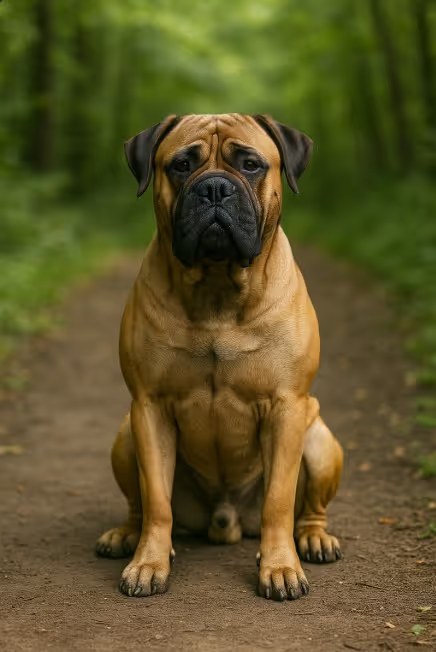The Bullmastiff is a powerful, dignified guardian—calm at home, courageous when needed, and famously devoted to family. Bred to silently apprehend poachers, the breed is confident, affectionate, and relatively low-energy indoors. If you’re asking “Are Bullmastiffs good family dogs?”—yes, in experienced homes with clear rules and early socialization. “Do Bullmastiffs drool?”—often. “Do Bullmastiffs shed?”—light to moderate. Heat management, joint care, and polite-manners training are musts.

Created in late 19th-century England by crossing Mastiffs with Bulldogs (roughly 60/40), the Bullmastiff was the gamekeeper’s night dog, bred to track quietly, rush, and pin poachers without mauling. Selective breeding fixed a powerful build, a dark mask, and a steady, reliable temperament. Recognized across major registries, today’s Bullmastiff remains a superb property guardian and loving companion when well trained and socialized.
A large, solid, rectangular Molosser with a broad head and black mask.
Low coat maintenance; routine skin and drool care.
Moderate, joint-friendly exercise; avoid heat and pounding.
Steady, intelligent, and independent—calm consistency is key.
Grow slow and keep lean for joint and heart health.
A robust guardian with size- and breed-linked risks—select for health-tested lines.
Temperament, health screening, and lifelong support matter.
Are Bullmastiffs good family dogs?
Yes—loyal and gentle in experienced homes with early socialization, training, and supervision due to size.
Do Bullmastiffs drool?
Yes—often after eating, drinking, or exercise. Keep towels handy.
Do Bullmastiffs shed a lot?
Light to moderate. Weekly brushing controls hair/dander.
Are Bullmastiffs hypoallergenic?
No.
How much exercise does a Bullmastiff need?
About 45–60 minutes daily of low-impact walks plus training/enrichment.
Are Bullmastiffs good apartment dogs?
Possible for committed owners with strong routines, space planning, and daily outdoor time; easier with a fenced yard.
Bullmastiff vs English Mastiff—what’s different?
Bullmastiffs are smaller, more agile, and more guardian-focused (bred to apprehend); English Mastiffs are larger, typically mellower, and more laid-back giants.
What health tests should breeders do?
Hips/elbows, cardiac (echo), CAER eyes, and thyroid; discuss bloat prevention and family cancer history.
How do I manage heat safety?
Walk at cool times, provide shade/water, avoid mid-day exertion, and monitor for heavy panting—never overheat a guardian breed.